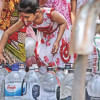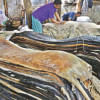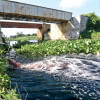Pollution From Waste: Buriganga water shows signs of improvement

However insignificant, the quality of Buriganga water is showing signs of improvement.
It comes after some big tanneries that used to dump their waste into the river shifted from the capital's Hazaribagh to Savar. Also, operations of the rest of the tanneries that have not yet shifted remain suspended, meaning they are not releasing any waste into the river either.
In addition, the Department of Environment (DoE) has recently shut down 19 factories of various types in Keraniganj. These factories too used to dump their toxic waste into the river.
The latest DoE test found the level of average dissolve oxygen (DO) in the Buriganga water was 0.1 in the first two months of this year compared to 0.00 in January and February last year.
It also found the level of BOD (biochemical oxygen demand) came down to 10.4mg per litre in January and 24.4mg per litre in February this year. It was 11.5mg and 29.1mg in January and February last year.
DO is the level of oxygen required for the survival of aquatic resources, while the level of BOD is the volume of organic waste materials in water.
In Bangladeshi context, the level of DO should be above five and that of BOD below six in dry season for any aquatic species to survive.
The DoE collects water sample from eight points of the Buriganga every month to monitor the water quality.
Though its latest test shows a slight improvement, the water is still far worse than the official standard.
"The level of BOD fell to 24 from 29 in the last one year. We consider it a huge improvement. The biodiversity of Buriganga will revive automatically if we can stop the discharge of untreated water in the river," said a DoE official.
Regular drives against water polluters are also yielding some fruits, he added.
The Buriganga and other rivers around the capital have become highly polluted over the years due to indiscriminate discharge of untreated industrial and household waste into them.
In Bangladesh, around 92 percent wastewater is seriously neglected while around 2.10 crore people drink unsafe water, said Prof Dr Md Mujibur Rahman of Buet, who has been monitoring the discharge of wastewater into the Buriganga for years.
"Every day around 60,000kgs of BOD is dumped into the Buriganga from industrial and domestic sources through 41 drainage outlets,” he told a seminar in the capital organised on the occasion of the World Water Day yesterday.
The theme of this year's World Water Day is “wastewater”.
In the Buriganga, the level of dissolve oxygen hovers between zero and one during dry season while it goes up to 4mg per liter during monsoon, said Prof Mujibur.
A few years ago, the government took up a Tk 21-crore project to clean up the waters of the Turag and the Buriganga.
But as the the river pollution continues unabated, dependence on groundwater has been growing in the capital.
Currently, around 78 percent of the city's water demand is met from below the ground, as most of the surface water is contaminated. This heavy reliance on groundwater causes the water table to lower three to four metres a year, said sources in Dhaka Water and Sewerage Authority (Wasa).
The level of pollution of rivers surrounding the capital is so high that the Wasa has taken an initiative to set up several treatment plants outside Dhaka to bring water from the Padma and the Meghna, said AKM Shahid Uddin, former chief engineer of Wasa.
“We wouldn't need to bring water from those rivers if the waters of the rivers around the capital were usable,” he said.

 For all latest news, follow The Daily Star's Google News channel.
For all latest news, follow The Daily Star's Google News channel. 








Comments